Having a bathroom onboard your travel rig is a great luxury and one that has never been more appreciated than it has been during the past couple of years. RV showers and toilets – and their treasured companions — RV wastewater holding tanks — make it possible to have a private bathroom no matter where you are… whether you’re traveling down the road or you’re camped in the middle of the desert. But what happens if your RV black or gray tanks are near capacity? Do you have to pack up and drive to the nearest dump station? Maybe. But not if you’ve got a portable RV dump tank.
Today we’re talking about a great alternative to moving your entire rig to dump your black or gray tanks, and a way to help extend your boondocking trips – the portable RV dump tank, sometimes referred to as a “Blue Boy” due to the color of many of the most common ones. While dumping is no one’s idea of a favorite topic of discussion, this one just might change the way you camp. Let’s take a look!
- 1) What is a Portable RV Dump Tank?
- 2) What to Look for in a Portable RV Dump Tank
- 3) What Size Portable RV Waste Tank Do I Need?
- 4) How Do You Empty a Portable RV Waste Tank?
- 5) How Do You Clean a Portable RV Dump Tank?
- 6) How Do You Transport a Portable RV Dump Tank?
-
7)
3 of the Best Portable RV Dump Tanks to Extend Your Camping Experience
- 7.1) Barker 4-Wheeler Tote Tank (25-Gallon, 32-Gallon, 42-Gallon)
- 7.2) Camco 39006 Rhino Heavy Duty Portable Waste Holding Tank with Hose and Accessories, (15-Gallon, 21-Gallon, 28-Gallon, 36-Gallon)
- 7.3) Camco 39000 Rhino Heavy Duty Portable RV Waste Holding Tank with Hose and Accessories (15-Gallon, 21-Gallon, 28-Gallon, 36-Gallon)
- 8) Who Needs a Portable Waste Tank?
What is a Portable RV Dump Tank?
A portable RV dump tank sometimes referred to as a portable waste tank, camper waste tank, or RV tote tank, is a small tank that connects to your RV’s sewer connection, allowing you to dump the waste from your black or gray water holding tanks into the portable tank for dumping without having to move your rig.
One of the two most common ways in which campers might use a portable RV dump tank is if they’re all set up at a campground, but their site doesn’t have its own sewer hookup. Two choices here: You can pack up the rig and drive it over to the campground dump station to dump the tank and then head back to the campsite and set everything back up again, or you can release the contents of your rig’s waste tank(s) into a portable dump tank, and take just the portable tank over to the dump station to dump it without uprooting your whole RV. (Keep in mind that you can’t dump the contents of your RV’s grey tank on the ground!)
The other common use for a portable RV dump tank is when you’re off the grid entirely. If you’re out boondocking in a remote, scenic location, you may be limited to how long you can stay by your gray and black water tank capacities (and your fresh water tank, as well).
If your waste tanks fill up, you’ve got to pack up and drive to the nearest dump station (which could be many miles away from your site), UNLESS you have a portable RV dump tank. In this situation, you’d dump your black (and perhaps the gray tank as well, depending on the tank sizes involved), into your portable dump tank, making room in your rig’s onboard tanks for you to continue your fantastic boondocking experience. It’s like having your own portable septic tank for your RV!
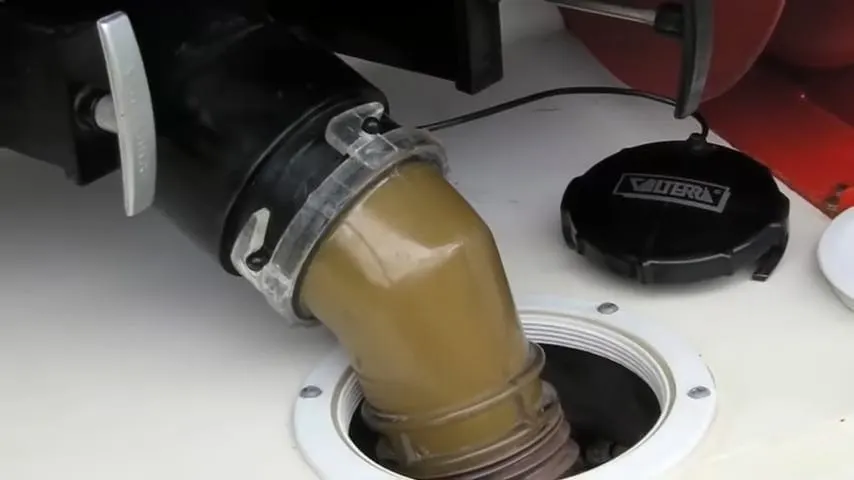
A portable RV dump tank allows you to dump the contents of your rig’s waste holding tanks into a portable tank, making room in your onboard tank to extend your stay without driving your whole rig to a dump station.
Now that you know what a portable RV dump tank is, let’s take a look at some of the features to look for in this type of portable tank, in case you’re interested in shopping for one, now or in the future.
What to Look for in a Portable RV Dump Tank
There are a few things to consider when shopping for a portable RV dump tank. Following are some things you’ll want to bear in mind when you’re shopping for – or even just looking into the possibility of – an external dump tank for your rig.
Tank Capacity
First, you’ll want to consider tank capacity.
What are the sizes of your RV’s black and gray water tanks? Let’s say for example that your rig has a 30-gallon black water tank. If you want to be able to completely empty your rig’s full black water tank into a portable tank, then you’ll obviously need a portable tank that holds at least 30 gallons.
But it’s very important to remember that a FULL 30-gallon camper waste tank is going to weigh in excess of 240 pounds. A gallon of water weighs 8.3 pounds – (and there’s more than water in your black tank) – plus you have to consider the weight of the tank itself.
Once you have a full portable tank, what are you going to do with it? We’ll get into the details momentarily, but one way or another you’re going to have to move the now-full portable tank. You’ll eventually need to get it to a dump station to be emptied and cleaned. So, you’ll need to consider this as well when you’re determining the size of the portable dump tank you want to buy… and the type of vehicle you may be using to move it.
Wheels
Some portable RV dump tanks have rubber wheels and others have plastic wheels. Some have two wheels, others have four. Even the width of the wheels on these tanks varies, with some wheels being wider than others.
In general, plastic wheels are less durable than rubber wheels. They’re replaceable, but they tend to break more easily, and when they do, some people may decide that it’s simpler to replace the entire tank rather than just the wheels.
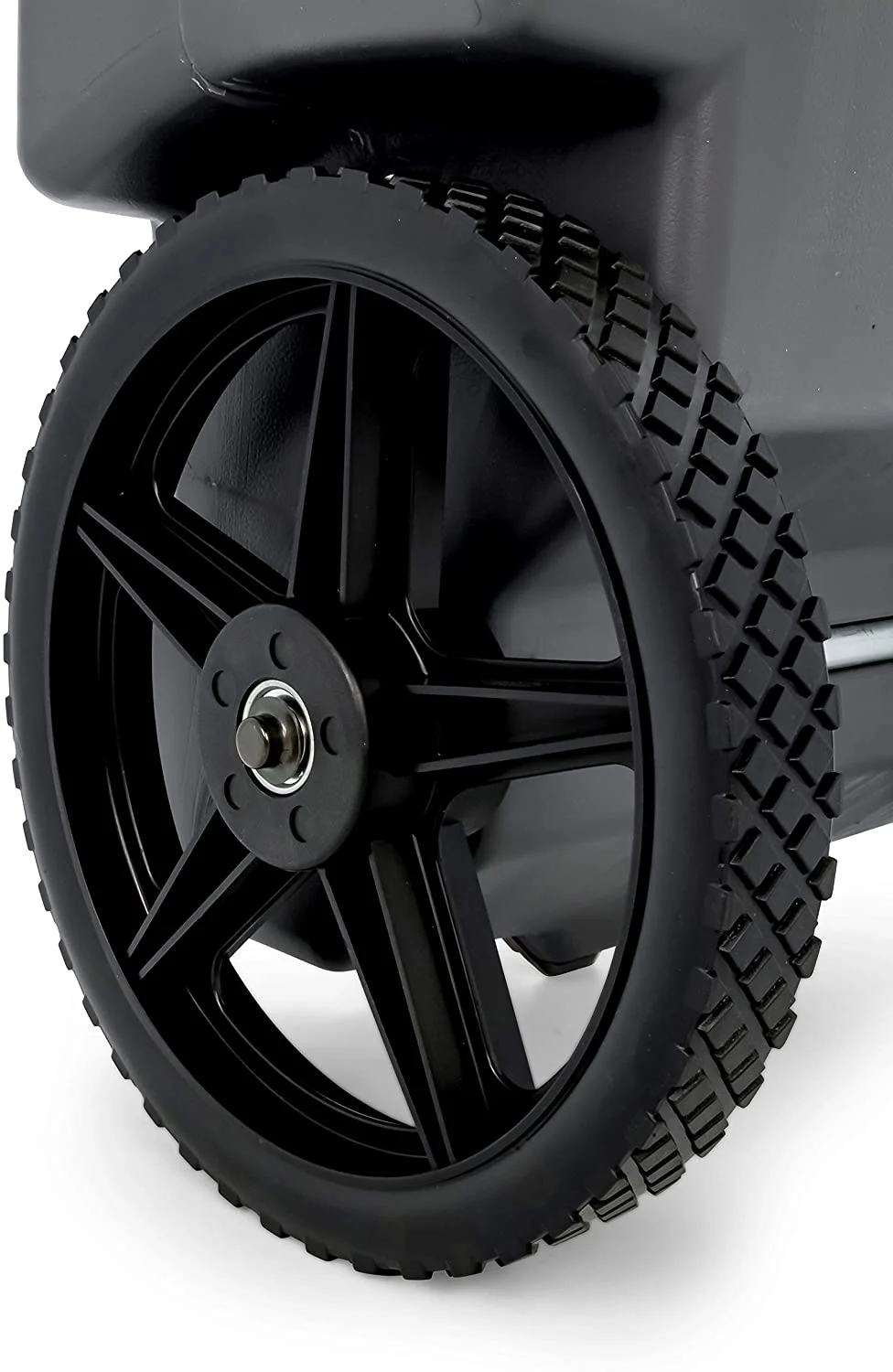
Some portable RV dump tanks have plastic wheels while others have rubber wheels. Rubber wheels are more durable and are often preferable in rough terrain. (Photo credit: Camco via Amazon.com)
Another advantage to rubber wheels is the ability to inflate them when necessary. Wider rubber wheels may be preferable depending on the terrain your tank will be rolling over when full.
You’ll also want to consider how you’re going to transport the portable camper septic tank to determine whether you want a four-wheel tank or a two-wheel tank.
Transportability
Transportability is key with a portable camper waste tank. You’ll need to get it to a dump station once it’s been filled up. There are a couple of ways to do this and we’ll get into those in just a minute. But when shopping for an RV dump tank, portability will need to be a consideration, and that includes how you’ll transport the tank when it’s empty.
Storage Options
Where you’ll store your dump tank when empty is something you’ll want to consider as well. For example, some folks carry their empty portable waste tanks strapped to the ladder of their RV. If that’s something you’d want to do, you need to make sure the tank is light enough when empty that you’re able to lift it high up to attach it to the ladder.
Likewise, if you’re going to be carrying it in a basement bay of a motorhome, you’ll want to consider its size in conjunction with the size of your storage bay (and the size of your bay door) and how much space you feel you can spare down there. That’s especially true for full-time RVers, for whom space is always a consideration.
What Size Portable RV Waste Tank Do I Need?
The answer to this question depends on the size of your RV’s black water tank and how you want to use the portable dump tank.
If you want to be able to dump the contents of your RV’s entire full black or gray water tanks, then you’ll need to buy a portable tank large enough to accommodate the entire contents of each of those tanks.
Remember that you can also partially empty your RV’s waste tank into a portable tank by simply closing your tank’s gate valve part-way through the dumping of that tank. This will buy you some time, though less than fully emptying your tank would afford.
PLEASE NOTE: Normally, you wouldn’t close the valve until the contents of the tank were completely empty, especially with the black tank. So interrupting the flow of waste from your black tank may mean that you could end up with “debris” clogging/blocking the valve from sealing correctly. For this reason (and our general aversion to manhandling a vat of black water as much as reasonably possible), we’d suggest that using a portable RV waste tank primarily for gray water may be preferred for many people. We’re lucky in that our gray tank almost always fills up before our black tank anyway. Your mileage may vary.
If you’re interested in easier transportability, and if you generally camp at a campground that has a dump station, you can buy a smaller, easier-to-transport portable tank, partially empty your RV’s black tank into it, take the portable tank to the dump station and empty it, and then repeat the process (right away or at a later time).
Also – if your portable RV dump tank doesn’t have a gate valve, you may need to lift one side of it to allow gravity to move the contents from the tank into the dump station’s sewer inlet. This is another consideration when deciding what size portable tank you want to buy.
So, consider how you want to use the portable tank and also consider the size of the tank or tanks you want to be able to empty or partially empty and determine your tank size from there. Just be sure to check out the weight of the tank itself, and calculate the weight of a given tank when filled, too, to be sure you can manage moving it as needed.
How Do You Empty a Portable RV Waste Tank?
You’ll empty your portable RV waste tank in a very similar manner to the way you empty your RV’s black water tank.
You’ll pull it up to the dump station, and one end of your sewer hose will be connected to the tank and the other end to the dump station’s sewer inlet. On the inlet side, if you aren’t using an appropriate sewer adapter (which you may not be able to at a dump station vs a full hook-up campsite) you’ll want to be sure to place something heavy, like a good-sized rock, to hold the hose in place during the dumping process.
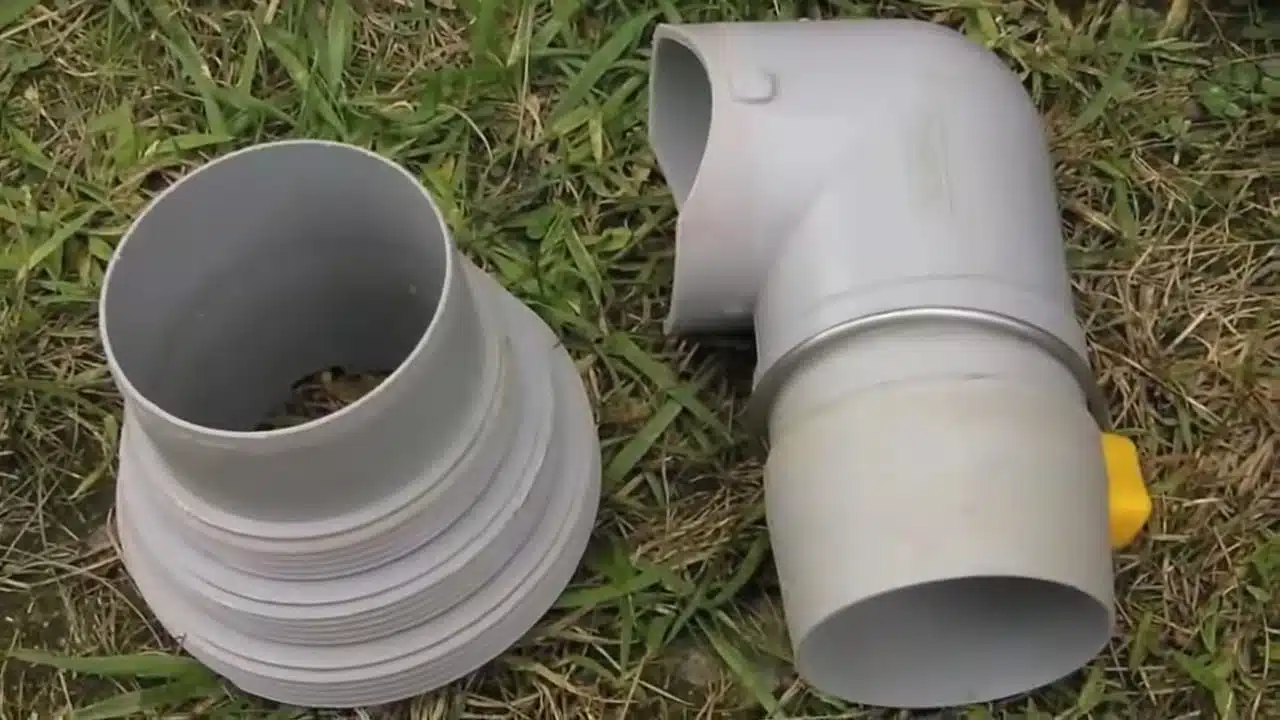
Using a sewer adapter may not be practical at many dump stations, as they generally don’t have threaded inlets like you’ll usually find at full hook-up campsites.
At this point, depending on the type of tank you have, you’ll either open the gate valve to evacuate the contents of the tank, or you’ll lift one side of the tank to allow gravity to move the contents into the sewer. There may also be a vent that needs to be opened for smooth evacuation of the contents to take place.
How Do You Clean a Portable RV Dump Tank?
To clean a portable dump tank you can simply fill it with water (be sure to never use a drinking water hose for this!), close the valve and give it a shake to rinse it out, then empty it into the sewer. You can do this several times until you’re satisfied that the tank is clean.
You may also wish to use a clear elbow (if one was not provided with your portable tank) so that you can see the contents to know when the tank is clean.
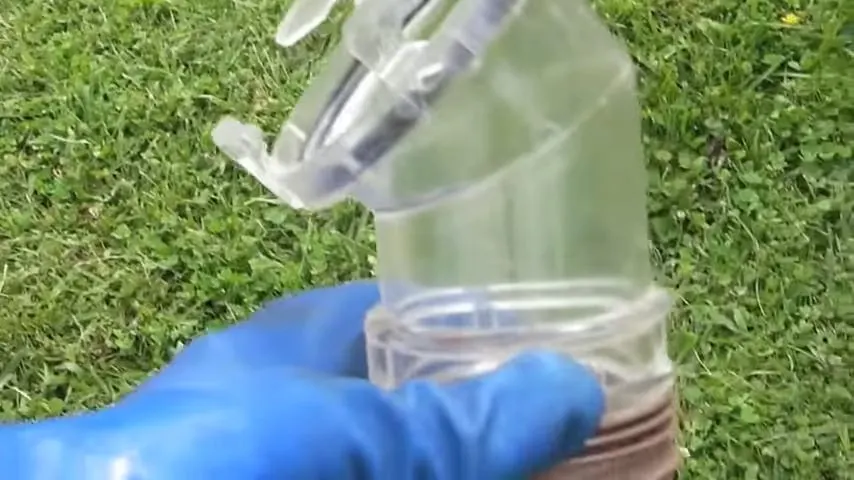
A clear sewer elbow will allow you to see when the contents of your tank are rinsing clear.
From time to time you may wish to use a tank treatment like this one to keep the tank cleaner and avoid odor buildup over time.
How Do You Transport a Portable RV Dump Tank?
Depending on size and style, a portable RV dump tank can either be walked to a nearby dump station (at your campground), or it can be attached to a hitch and driven SLOWLY to the campground’s dump station.
It’s very important to remember that you can’t attach a portable dump tank to your RV’s hitch and drive along the highway at 65mph to a dump station after leaving a boondocking site. These tanks are not meant to travel this way. It’s one of those “goes without saying” things we thought we’d say anyway.
This is another reason why it’s important to choose your tank size/capacity wisely, always bearing in mind how you’ll be moving the tank once it’s full. If you plan to transport your full portable waste tank to the dump station in the bed of a pick-up truck, you’ll almost certainly be limited to an unreasonably small tank… or have to be extremely strong!
One alternative that might allow a very fit person to transport the contents of a portable waste tank in a pick-up would be carrying a ramp that allows you to roll it up into the bed. If you travel with a motorcycle or ATV in the truck’s bed, you may already carry a ramp with you. But a full portable waste tank will still be very heavy, with the ramp at quite a steep angle, so considerable strength would still be required.
3 of the Best Portable RV Dump Tanks to Extend Your Camping Experience
Let’s take a look at three of the best portable RV dump tanks on the market today.
Barker 4-Wheeler Tote Tank (25-Gallon, 32-Gallon, 42-Gallon)
Barker’s 4-wheel tote tank is available in three sizes including a 25-gallon, 32-gallon, and 42-gallon size. Constructed from blow-molded polyethylene, all sizes of this tank have two front-mounted swiveling wheels to make it easier to move and maneuver the tank. The tires are rubber. And you can see how its color helped give the “Blue Boy” its popular nickname!
Barker tote tanks have a 3” gate valve so the tank doesn’t need to be lifted to encourage a gravity evacuation. Simply attach one end of your sewer hose to the hose connection on the tank and the other end to the sewer inlet at the dump station, and open the gate valve.
The tanks all come with a long handle (metal tow bar with a 2-inch ball loop) to allow transportation by hand (as you’d roll a suitcase) or by vehicle, golf cart, etc.
They do come with a hose, but the tanks don’t offer a way to carry the hose or accessories on the tank itself. But it does have a fill gauge so that you can see how full the tank is getting as it’s being filled – a very important feature (and handy if you’re using the tote as extra gray tank space… you can leave it connected with the gray valve open and easily know how full it is)!
Reviews for the Barker 4-Wheeler Tote Tanks are overwhelmingly excellent.
- Fit Type: Universal Fit;Fit Type: Universal Fit
- Double wheel, front-swivel design for easy pulling and maneuvering
Camco 39006 Rhino Heavy Duty Portable Waste Holding Tank with Hose and Accessories, (15-Gallon, 21-Gallon, 28-Gallon, 36-Gallon)
Camco’s Rhino heavy-duty portable waste tanks have gate valves to make tank-emptying easier and come with an integrated ladder hook to clamp the tank to your RV’s ladder when not in use. They have a removable steel tow bar to allow the tank to be rolled (as you’d roll a suitcase), but they don’t have a gauge to see how full the tank is getting as you fill it.
These tanks have two rear wheels, and while reviews for the tanks are overwhelmingly positive, a few users did mention that the wheels have not held up as well as they hoped under the stress of a full tank or over many uses.
In general, reviewers are very satisfied with these tanks, noting that they’re heavy-duty and very easy to use at the dumpsite.
The 28-gallon and 36-gallon tanks come in a 4-wheel version as well.
- SIMPLIFY RV WASTE DISPOSAL: Make waste disposal hassle-free with Camco's portable waste tank. Easily transport waste from your RV black water tank to...
- EFFORTLESS TRANSPORT: Haul your waste with ease with no-flat wheels built for any terrain, an oversized handle for easy maneuvering, & a steel tow...
Camco 39000 Rhino Heavy Duty Portable RV Waste Holding Tank with Hose and Accessories (15-Gallon, 21-Gallon, 28-Gallon, 36-Gallon)
Also on our list are Camco’s 3900 Rhino series of tanks. These tanks come in four different capacities and the hose and accessories necessary to use and dump the tanks are provided.
These are very heavy-duty tanks and are among the most popular options offered on Amazon with nearly 19,000 reviews, 94% of which are 5- and 4-star reviews.
The Camco 39000 series has two oversized wheels, an included tank rinser, a ladder hook, and comes with a sewer hose with swivel bayonet, a clear elbow with adapter, storage caps, and a steel tow adapter.
The tanks are constructed of blow-molded, UV-stabilized HDPE.
- SIMPLIFY RV WASTE DISPOSAL: Make waste disposal hassle-free with Camco's portable waste tank. Easily transport waste from your RV black water tank to...
- EFFORTLESS TRANSPORT: Haul your waste with ease with no-flat wheels built for any terrain, an oversized handle for easy maneuvering, & a steel tow...
Who Needs a Portable Waste Tank?
Anyone who regularly camps without a sewer connection right at their site might benefit from a portable RV dump tank, especially if they’d like to be able to remain at their campsite for longer than their RV’s waste tanks otherwise allow.
Folks whose rigs have small tanks would likely find a portable waste tank advantageous, as would boondockers who’d like to be able to extend their stay off the grid without having to break camp to drive their RV to a dump station. We’ll reiterate for boondockers, though, that you need to have a plan to transport your full portable waste tank to a dump station.
Geek Out with Us Every Week
Join our newsletter to learn about all things RV-related. Every week we offer free tips, tricks, product reviews, and more to our online community of RVers. So, whether this is your first time on the road or you’re a seasoned expert, we’d love for you to geek out with us!

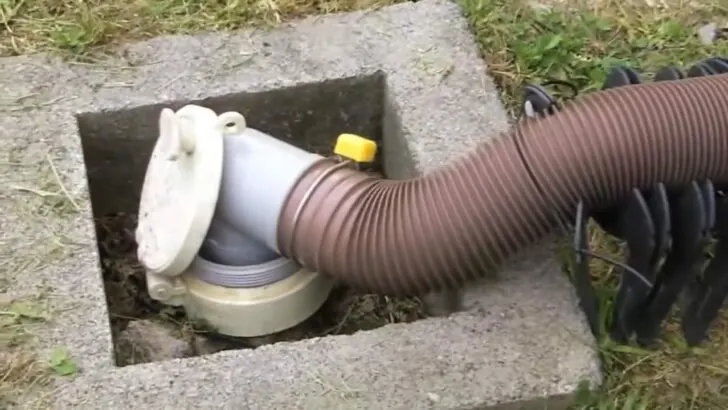



LInda
Friday 6th of May 2022
I have a small cargo van RV; it only has a 7 gallon grey water tank (no black tank). I am trying to find a SMALL portable dump tank; between 5 and 10 gallons. Do you have any recommendations for that size?
TheRVgeeks
Friday 6th of May 2022
Hi Linda. We'd recommend sticking with either the Barker or Camco brands... each of which does offer smaller units (though they may only go down to about 15/16 gallons), but there are also smaller offerings from other brands if you absolutely must get a smaller one. We just can't vouch for their quality or long-term durability.
Doug LaFeve
Monday 13th of December 2021
Howdy, I have the 42 gallon Barker “blue” tank. Generally pleased with it but there is one drawback, when trying to use the fill gauge and attaching a 3” hose to the top fill you will find that the tank WILL NOT FILL. This is due to the fact that there is no air pressure release when you have the gauge installed. This results in having to loosen the gauge to allow air pressure to be released and can result in a spill if you overfill accidentally.
I have purchased a relief valve (similar to what you would find on a water heater, made of brass. I plan to install near the front top of the tank to release air pressure and still be able to use the gauge, which is necessary when emptying my 63 gal grey tank.
Another disadvantage is you can not connect a pump dump system like Thetford Sanicon to the tank as it is a multi threaded connection designed for a ground dump inlet and the tank inlet is a bayonet connection designed for standard hoses. This means you have to hold the hose to the inlet to empty, fraught with potential spill problems and may require two people, one to handle the hose and one to man the switch for emergency shut off if needed. Another issue to deal with is hose elevation from outlet to tank for either pump or gravity feed to the tank.
Thank you guys for what you do, I have followed your youtube videos now for 3.5 years and enjoy you presentation and quality of the video and the information shared.
Don’t be put off by Mr. Hall’s post. Waste water disposal techniques and alternatives are extremely important, much information is needed, especially for new RV users.
TheRVgeeks
Monday 13th of December 2021
Thanks, Doug. Great to hear real-world use experience with a product. We're guessing that Barker planned for people to use the tank with their gray valve open... so small amounts flow into the tank (leaving room in the sewer hose for air to escape) rather than to "dump" into it. And we're wondering if there are any adapters that would allow you to connect your macerator hose to the tote (instead of standing there holding it). We haven't seen all of the connections in person, but sounds like there SHOULD be something! ????